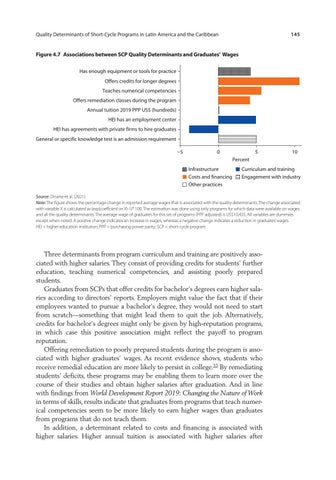145
Quality Determinants of Short-Cycle Programs in Latin America and the Caribbean
Figure 4.7 Associations between SCP Quality Determinants and Graduates’ Wages Has enough equipment or tools for practice Offers credits for longer degrees Teaches numerical competencies Offers remediation classes during the program Annual tuition 2019 PPP US$ (hundreds) HEI has an employment center HEI has agreements with private firms to hire graduates General or specific knowledge test is an admission requirement −5
0
5
10
Percent Infrastructure Costs and financing Other practices
Curriculum and training Engagement with industry
Source: Dinarte et al. (2021). Note: The figure shows the percentage change in reported average wages that is associated with the quality determinants. The change associated with variable X is calculated as (exp(coefficient on X)-1)* 100. The estimation was done using only programs for which data were available on wages and all the quality determinants. The average wage of graduates for this set of programs (PPP adjusted) is US$10,435. All variables are dummies except when noted. A positive change indicates an increase in wages, whereas a negative change indicates a reduction in graduates’ wages. HEI = higher education institution; PPP = purchasing power parity; SCP = short-cycle program
Three determinants from program curriculum and training are positively associated with higher salaries. They consist of providing credits for students’ further education, teaching numerical competencies, and assisting poorly prepared students. Graduates from SCPs that offer credits for bachelor’s degrees earn higher salaries according to directors’ reports. Employers might value the fact that if their employees wanted to pursue a bachelor’s degree, they would not need to start from scratch—something that might lead them to quit the job. Alternatively, credits for bachelor’s degrees might only be given by high-reputation programs, in which case this positive association might reflect the payoff to program reputation. Offering remediation to poorly prepared students during the program is associated with higher graduates’ wages. As recent evidence shows, students who receive remedial education are more likely to persist in college.33 By remediating students’ deficits, these programs may be enabling them to learn more over the course of their studies and obtain higher salaries after graduation. And in line with findings from World Development Report 2019: Changing the Nature of Work in terms of skills, results indicate that graduates from programs that teach numerical competencies seem to be more likely to earn higher wages than graduates from programs that do not teach them. In addition, a determinant related to costs and financing is associated with higher salaries. Higher annual tuition is associated with higher salaries after

